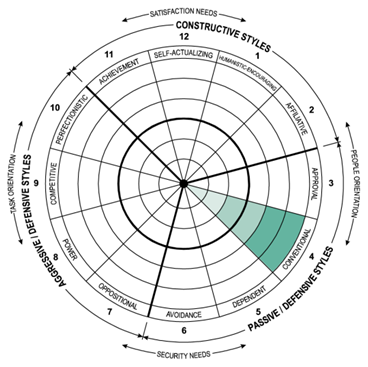In a previous article, we introduced the Human Synergistics Circumplex™, a proven framework to measure, report, discuss and better understand individual and collective human behaviour, and their impact upon business and organisational performance (refer: Catching Smoke: A Proven Framework for Addressing Culture and Leadership).
This month’s article focuses on one of the Passive/Defensive styles – Conventional: what it is, how it can hinder your personal effectiveness and/or the performance of your business/organisation and how you can you reduce personal conventional tendencies, or those which might exist in the culture of your workplace.

So Just What is the Conventional Style?
Whether we’re looking at it from an individual leadership or broader workplace culture perspective, a driving characteristic of the Conventional style is the desire to “be safe” by conforming with established practices, routines, ways of doing things.
Leaders high in the Conventional style will tend to, for example:
- view rules as a source of comfort and security
- want to “fly under the radar”, rather than be seen or noticed
- be overly-concerned with what others think of them
- be reluctant to embrace new ways, new ideas, and
- avoid risk.
Workplace cultures can themselves become Conventional in nature, in which it becomes “the done thing” for participants to, for example:
- just follow the rules, the way things have always been done, without questioning
- ensure that they are not the one blamed for mistakes
- if there is not an established practice, then wait to be told what to do rather than exercise initiative or independent thinking, and
- not readily value ideas, innovation or embrace change.
So Why Should I be Concerned?
Research over several decades by Human-Synergistics has consistently shown that workplaces high in the Conventional style (and other Defensive styles) are significantly less effective than workplaces with predominantly Constructive cultures.
Indeed, primarily constructive workplaces:
- are 32% more able to effectively respond to changes in the external environment
- achieve 32% higher quality performance
- demonstrate 28% more effective teamwork
- have a 25% greater commitment to producing a quality result
- have individuals that are 32% more motivated, 26% more satisfied and 25% more likely to stay with the organisation.
Individual leaders engaged in highly Conventional thinking and behaviour tend to find it tough to realise their own or their team’s potential, identify and pursue opportunities, think “outside the box”.Similarly, workplace cultures high in Conventional behaviours tend to:
- be overly traditional, too conservative, not open to new thinking or ideas
- be unexciting, even boring places in which to work
- find it difficult to make decisions, particularly where new thinking is required
- have difficulty recruiting and retaining, forward-thinking, dynamic staff, and
- become bureaucratic.
This is not to say that Conventional thinking and behaviour is all bad – it’s not. A degree of conformity, doing things the “tried and tested” way, complying with regulations and valid policies and procedures, is important and necessary for all organisations. It’s when Conventional thinking and behaviour is present to the extent that it impedes new thinking, blocks us off from improvement opportunities, restricts our problem-solving and decision making capacity (as individuals or as a business/organisation) that It becomes a problem.
OK, So How Can We Reduce Conventional Tendencies?
If you’ve read this far and come to the conclusion that your own performance, and/or that of your business/organisation may be hindered by an overdose of Conventional thinking and/or behaviour, there are some things you can you do to reduce its presence and get back on track.
At an individual leadership level, for example:
- break out of your usual routine and do something different (take small steps – drive to work a different way, wear something different, undertake a small work task differently)
- make a point to remind yourself that your differences are what make you unique and special, that your sense of self-worth does not relate to how well you “fit in” with others
- trust you “gut” a bit more – take a moderate risk, challenge a process or established practice, and/or
- make a point to identify and embrace a new idea (be it yours or someone else’s).
At a collective/workplace level, for example:
- publicly recognise the successful new ideas of others, to send a signal that it’s OK to think differently, and encourage others to do the same
- undertake an audit of the operative “rule”, policies and procedures within your business/organisation. Are there ones that you can live without, to give people more scope and encourage independent thinking?
- when recruiting, look for diverse candidates , and/or those with less-than-conventional thinking, to stimulate new ideas within the workplace and demonstrate that “it’s ok” to be different, and in fact it can add great value to the business
- consider opportunities to redesign jobs within the business – to allow more scope, individual thinking, increased delegation, and/or
- when someone does question an established “rule”, policy or practice, be sure to respond constructively so that they are encouraged to keep thinking even if this first idea doesn’t quite hit the mark.
We’ll continue in future articles to look at the what, why and how of other workplace culture and personal leadership styles. In the meantime, be sure to call if you’d like to explore the range of culture and leadership programs we have available to help transform your people, your team and your business/organisation.
If you’ve missed our previous articles on the other styles, be sure to check out our blog – look for the “Focus on Culture and Leadership” series of articles.

